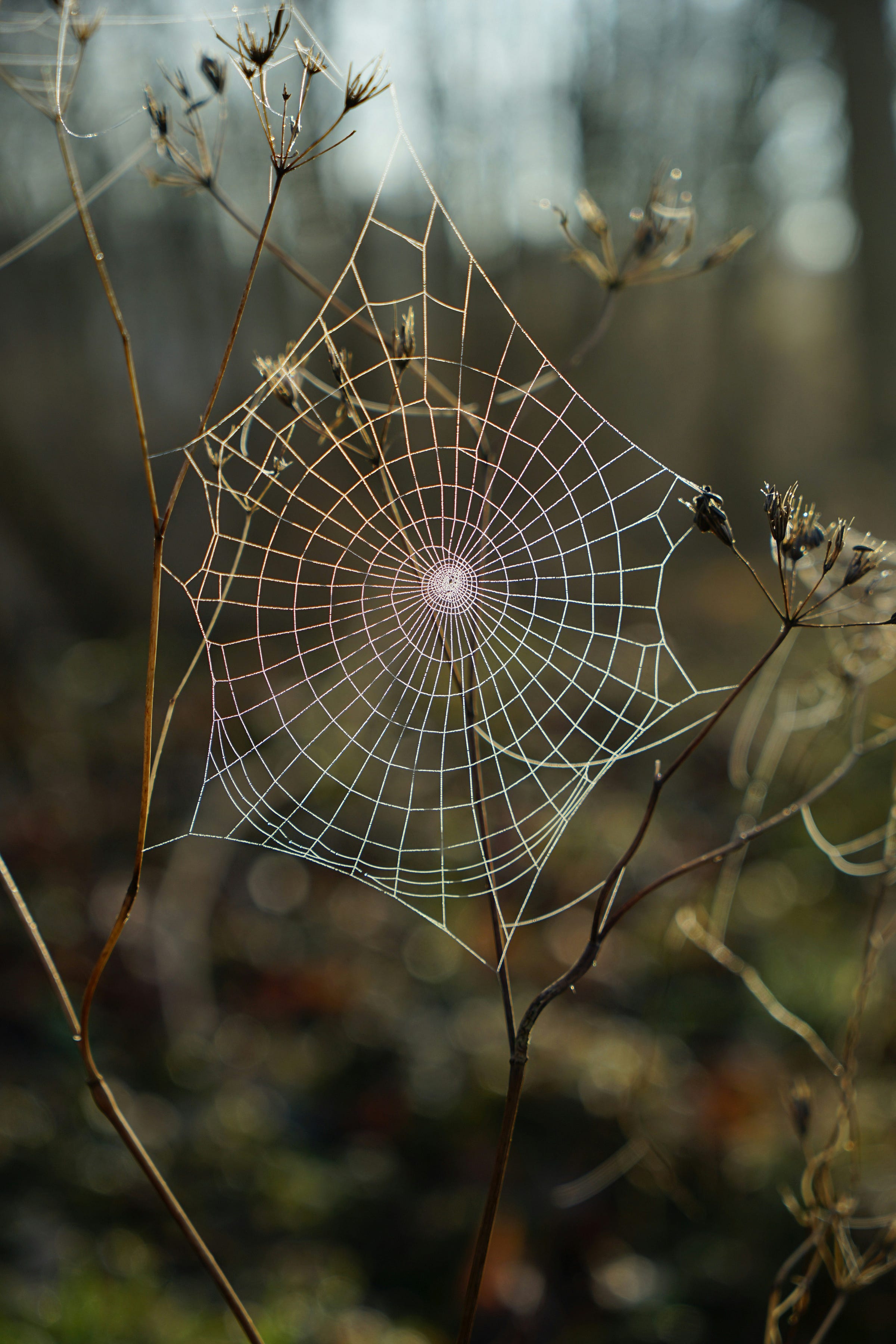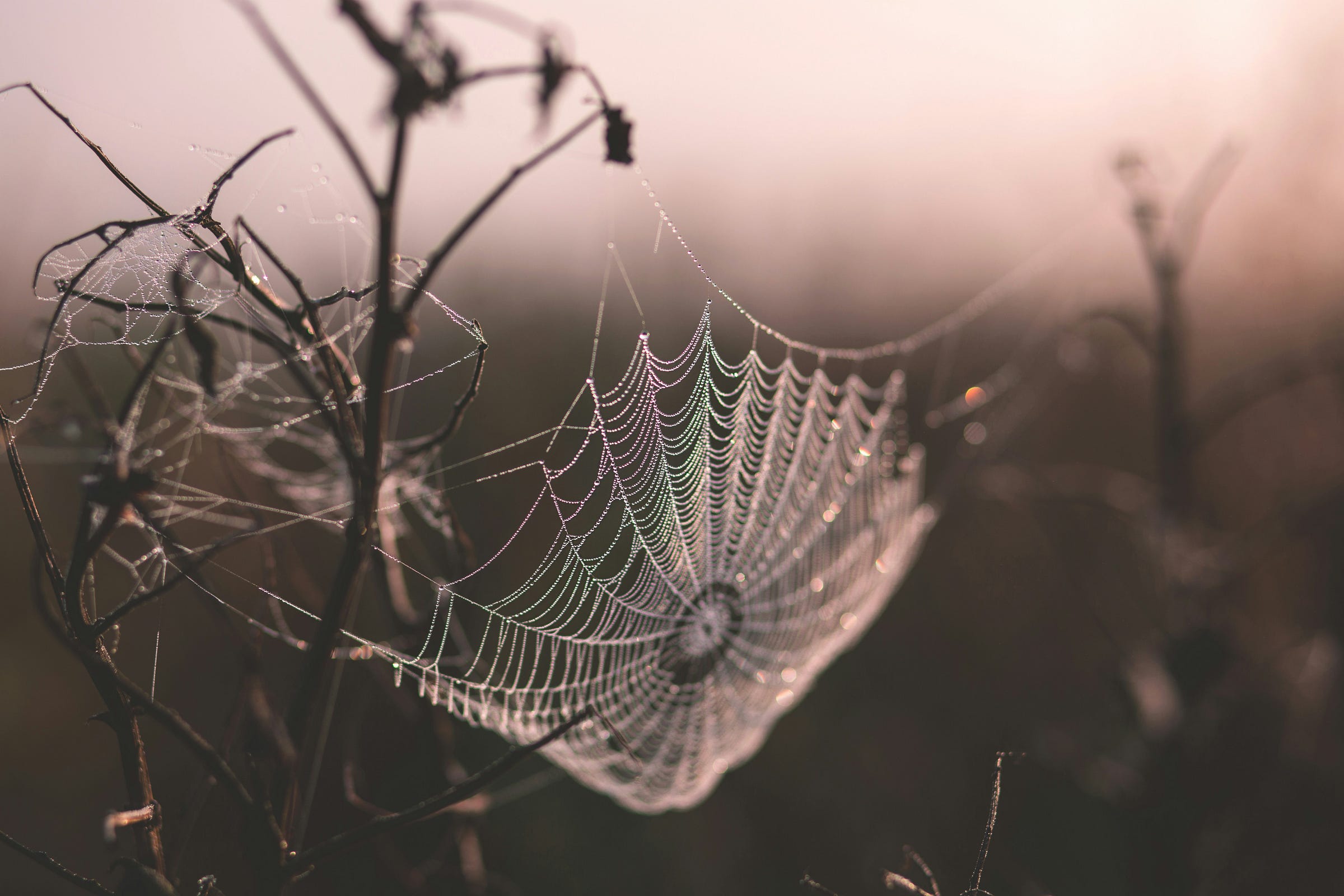Spider Webs Aren't Just for Halloween
Watching a spider weave its web can open a secret door into the natural world.

by Richard Conniff
I’m heading out of the country on assignment for the next three weeks, so the rush of prepartions and the season bring this story to mind. I wrote it for National Geographic, and included it in my book Swimming With Piranhas at Feeding Time. For me as a deadline-driven journalist, writing about spider webs was a great lesson in slowing down to see the world more clearly. With life outside my door now slowing down for winter, it’s also a reminder that you wild things live inside the house too. Spider webs are all too easy to observe. Just put down that vacuum cleaner! This is the first of three parts, which I’ll continue publishing over the next two Saturdays.
One afternoon in the courtyard of a hotel on the outskirts of San José, Costa Rica, a biologist named Bill Eberhard bent over a patch of garden where nothing much seemed to be happening. He held up a double layer of old gym socks stuffed with cornstarch and tapped it softly. Pa-pa-pa-pa-pa-pa-pa-pa. A cloud of white dust drifted across the garden and settled on every surface. Like images taking shape in the darkroom, spider webs began to materialize.
“They come out of nowhere,” Eberhard said. There were five or six of them in an area of about a square foot, most of them classic orb webs, with spokes radiating out from a hub. Each orb was perfect in its way, with a thousand or more delicate intersections, each skewed to its own peculiar catching angle, and each, until the moment the powder settled, nearly invisible. For insects on the wing it must have been like swimming through a bumper-to-bumper sea of fishing nets. Except that some spiders, unlike human fishermen, eat their nets and reweave them up to four times in a day. “These are just the ones they’ve rebuilt since it stopped raining,” said Eberhard.
Spider webs are everywhere, and if they happen not to be somewhere at the moment--for instance, in the living room you have just compulsively vacuumed clean--they will almost certainly be there soon: When a spider yearns to travel, it climbs up to a high point and pays out enough thread to catch the breeze and balloon itself skyward, with limbs akimbo for maximum float. These aeronautic maneuvers can take a spider more than two miles high and 200 miles cross-country, though a typical trip may last no farther than the next bush. This form of travel is so routine that in one study of a two-and-a-half-acre field 1,800 spiders drifted in on their gossamer parachutes each day, like paratroopers over France during the invasion of Normandy. All of them armed and dangerous, at least to insects: A British researcher once calculated that local farmland harbored more than two million spiders per acre--and that the insects consumed by spiders each year nationwide would easily outweigh the human inhabitants.
The chief weapon in this endless slaughter is, of course, the spider web, and the soldiers are mostly female. Males typically abandon web building when they reach maturity and instead wander around making love, not war. But females need the protein from insect prey to produce eggs, and they weave webs throughout their lives.
In the beginning, roughly 400 million years ago, spiders used their silk mainly to weave a hiding place, possibly with a trip wire out front to detect insects. But then the reclusive and wingless spider suddenly took to the open air.
“The reason spiders evolved aerial webs in the first place,” says Jonathan Coddington, of the Smithsonian’s National Museum of Natural History, “is that insects evolved wings.” Tarantulas, trap-door spiders, and some other species still use their silk mainly for shelter, but about a third of the 35,000 known spider species (Coddington estimates there may be 135,000 more) are orb-web weavers, and another third weave sheet webs, cobwebs, and other implements of insect death.
You get a sense of how clever these weapons can be on a short walk with Eberhard, a lean, taciturn field biologist on the faculty at the University of Costa Rica and the Smithsonian Tropical Research Institute. One morning at La Selva Biological Station, in the Atlantic foothills of Costa Rica’s central mountain range, Eberhard and I went out wading waist-deep in a rain forest stream, with our faces down close to the surface. Watching spiders means narrowing the scope of your world and moving in millimeters, and Eberhard is a master at this.
He does not hesitate to hum to a spider (spiders can associate particular prey with a specific musical note) or to pick one up with his fingers for detailed examination. (”When squeezed gently on the abdomen,” he has written, one spider “produced a strong, somewhat disagreeable odor reminiscent of ... lampyrid beetles and canned string beans.”) He has been bitten just once. I asked if this was because the threat of spider bites is grossly exaggerated or because he is careful about which spiders he grabs. “Both,” he said.
We were looking for a spider in the genus Wendilgarda, which strings a sort of tightrope across a stream and “glues” its web to running water. After an hour of searching, Eberhard called me over and said, “Here’s one,” indicating a spider smaller than a freckle, suspended above the water between the drooping leaves of a dieffenbachia. He took out the cornstarch and went pa-pa-pa-pa-pa-pa-pa-pa.
“Part of the Zen of this is you find a thing like this and you leave it alone,” Eberhard whispered, a subtle attempt to get an outsider to throttle back and see the world in spider time. “You get a little powder on it and figure out which lines are connected to which and which plants are connected, so you can see how to move around it without disturbing it.”
The powder revealed 13 separate lines down to the surface, like the leaders on a fisherman’s trotline. The riffle of the stream kept the end of each line skating back and forth in search of water striders. After about 15 minutes, irritated by the weight of the powder, the spider began to cut away the old lines and replace them. It descended to the surface on a thread, like a mountain climber on a rappel, and dabbed the water with the silk spinnerets on its hind end.
I asked how this brief maneuver can attach a silken thread to running water, something humans cannot achieve with our best superglues. Eberhard suggested that the attachment was more like a sea anchor, a burst of threads held in place by surface tension. The spider climbed halfway back up, then down to the surface again, this time applying a length of a special sticky silk to entangle its victim.
“You have an essentially blind animal with a limited nervous system building a complicated structure in an unpredictable environment,” said Eberhard. “The spider makes what for a human would be very complex calculations: ‘How big is the open space? How much silk do I have? What attachment points are available?’ Spiders are not little automatons making the same thing over and over. They’re flexible. And they’re not stupidly flexible; they’re smart flexible.”
Among other accomplishments, Eberhard discovered a species that has reduced its web to a sort of spitball on a thread. It imitates the perfume of a female moth to lure male moths into its neighborhood, then beans them with the spitball and reels them in. He named the species dizzydeani, after the celebrated pitcher who used to do the play-by-play on baseball games when Eberhard was a kid in Arizona.
That evening, with a headlamp on, Eberhard set out for a walk in the rain forest at La Selva. We stopped almost immediately to watch an ant walk into a spider’s sticky thread, which instantly yanked it into the air, legs flailing. Eberhard turned--and again stopped almost immediately, at a web consisting of a single unsticky strand on which insects roosted like birds on a wire. A green spider lurked nearby, its long, thin abdomen curled up like a tendril. Its technique is to creep with vinelike patience toward an insect using the roost it has provided. It reaches out its front legs and gently, almost imperceptibly, tastes the insect with the hairs on its feet. Then, in a flurry, the spider wraps its prey in silk. Eberhard started to walk and, again, stopped. His headlamp picked out a classic orb web, with the concave shape of a satellite dish.
“Watch this,” he said. He touched the web from behind, and it sprang forward. Then, magically, it became concave again. The spider, said Eberhard, uses a spring line running straight back from the hub to winch the web into the cocked position. “Some prey, like mosquitoes, fly very tentatively, with their forelegs out, and as soon as they touch a web, they back off.” So this web springs out to follow them. Our walk continued like that, stop and start from web to web. After a couple of hours, having journeyed through an entire deadly universe in miniature, we turned back. We had covered all of 50 yards.
“That’s how it is with spiders,” Eberhard said. “You go nowhere.”
The second episode, in which I attempt to weave my own man-size spider web, will appear here next Saturday.
Other Reading and Viewing
You can find other stories like this in my book Swimming with Piranhas at Feeding Time: My Life Doing Dumb Stuff with Animals (W.W. Norton). You can find it on Amazon or on Bookshop.org, which helps support your local book dealer.
Here’s a decent video of different spider web types.



Fantastic! What a nice morning read.
Fascinating! It feels like there are more spiders in and around my house this year. I figure that's a good sign, or maybe I'm just not cleaning as often....